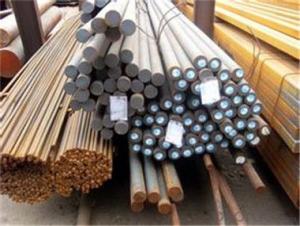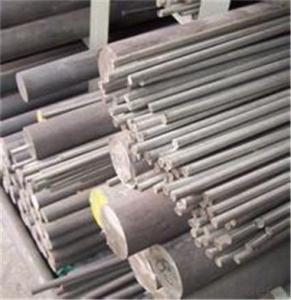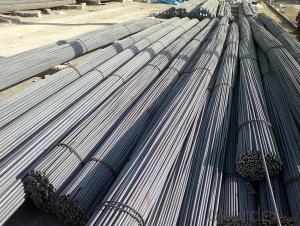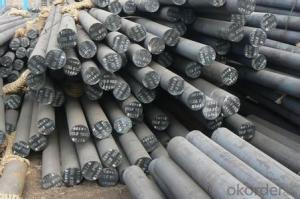Steel Round Bar Reliable Manufacturer with Good Quality
- Loading Port:
- Tianjin
- Payment Terms:
- TT OR LC
- Min Order Qty:
- 20 m.t.
- Supply Capability:
- 2000000 m.t./month
OKorder Service Pledge
OKorder Financial Service
You Might Also Like
Item specifice
Description of steel round bar:
1.Diameter 80 to 800 mm
2.Black or Bright surface
3.Annealed or Quenched and tempered provided
4.Cutting service provide
Festures of steel round bar:
4340 Forged Round Steel Bar
1.Dia 80-800mm Length:2000-13000mm or as required
2.Technique:Forged
Cold work tools
Cutting and pressing tools
Cavity moulds
Measuring tools
Stamping tools
Deep drawing tools and presses
Industrial shears
Specifications of steel round bar:
1. Standards: AISI 4340 8620 8640 4320 , JIS SNCM8 GB:40CrNiMoA
2. Specification: Dia: 80~450mm Length:2000-13000mm or as required
3. Process: EAF+LF+VD ( necessary) UT+ Peeled +Turned + Heat Treatment (optional)
4. Chemical Composition (%):
C | Si | Mn | S | P | Cr | Ni | Cu | Mo |
0.37-0.44 | 0.17-0.37 | 0.40-0.80 | 0.025(max) | 0.025(max) | 0.60-0.90 | 1.25-1.65 | 0.025(max) | 0.15-0.25 |
Images of steel round bar:
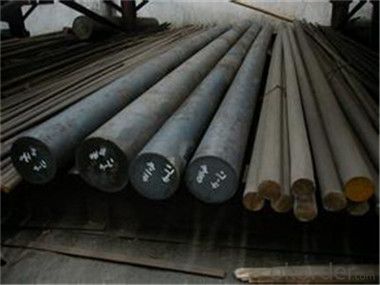
FAQ:
1. What is your package?
Packing situation: standard seaworthy packing or as customer required.
2. How long is the lead time?
Delivery time: 45 days after order confirmed.
3. What payment term do you accept?
Payment: T/T or L/C at sight.
- Q:Three - grade thread Phi 10 steel can replace a grade Phi 12 round bar? Which elder knows, trouble pointing.
- The general situation is not possible, but sometimes as stirrup time, and has little effect on the structure, if 12 reinforced with missing a few, but not on the main force position is possible, sometimes supervision is not allowed.
- Q:What are the advantages of using nickel-chromium-aluminum alloy steel round bars?
- Nickel-chromium-aluminum alloy steel round bars offer numerous benefits. Firstly, they possess exceptional corrosion resistance, making them ideal for use in harsh environments or industries where corrosion is a concern. This resistance to corrosion prolongs the lifespan of the round bars, reducing maintenance and replacement expenses. Secondly, these round bars are known for their high strength and durability, making them suitable for applications that involve heavy loads or high temperatures. Their strength also enhances structural stability, making them a dependable option for construction projects and industrial applications. Additionally, this alloy steel demonstrates excellent thermal stability, allowing it to maintain its shape and mechanical properties even under elevated temperatures. This attribute is particularly advantageous in industries such as aerospace, automotive, and power generation, where high temperatures are prevalent. Furthermore, nickel-chromium-aluminum alloy steel round bars offer good formability and machinability, facilitating easy fabrication and customization. This versatility allows for the production of intricate shapes and designs, making them adaptable for various manufacturing processes. Lastly, this alloy steel is recognized for its resistance to oxidation and scaling at high temperatures. This makes it suitable for applications involving exposure to extreme heat or rapid temperature changes, such as in furnaces or heat exchangers. In conclusion, the benefits of utilizing nickel-chromium-aluminum alloy steel round bars include exceptional corrosion resistance, high strength and durability, thermal stability, formability, and resistance to oxidation. These qualities make it a preferred choice for a wide range of industries, ensuring reliable performance and longevity in various applications.
- Q:Can steel round bars be used for making automotive chassis?
- Certainly, automotive chassis can be constructed using steel round bars. Due to its impressive strength and durability, steel is a prevalent material in the production of automotive chassis. The utilization of round bars made from steel ensures outstanding structural integrity, allowing them to endure the immense loads and forces that a vehicle's chassis encounters. Moreover, incorporating steel round bars in automotive chassis contributes to enhancing the overall safety of the vehicle by providing a robust and inflexible frame. Furthermore, steel is reasonably affordable and easily accessible, rendering it a favored selection for automotive manufacturers.
- Q:What are the advantages of using manganese-alloy steel round bars?
- Manganese-alloy steel round bars offer several advantages. Firstly, they possess excellent strength and durability, making them ideal for applications that require high load-bearing capacity. Secondly, the presence of manganese in the alloy enhances hardenability, resulting in improved wear resistance and toughness. This makes manganese-alloy steel round bars suitable for use in environments with abrasive conditions or high impact forces. Additionally, these round bars exhibit good machinability, allowing for easy fabrication and shaping. Lastly, the corrosion resistance of manganese-alloy steel ensures a longer lifespan, reducing maintenance requirements and costs in various industries.
- Q:Can steel round bars be used in high temperature applications?
- Yes, steel round bars can be used in high temperature applications. Steel is known for its excellent strength and durability, even at high temperatures. However, the specific type of steel and its composition should be considered to ensure it is suitable for the particular high temperature environment and application. Additionally, proper heat treatment and other measures may be necessary to enhance the steel's resistance to high temperatures and prevent any potential degradation or failure.
- Q:What is the difference between a hot rolled and a cold drawn steel round bar?
- The main difference between a hot rolled and a cold drawn steel round bar lies in their production process and resulting characteristics. Hot rolled steel round bars are produced by heating a billet or ingot to a high temperature and then shaping it into the desired form, typically through rolling. This process results in a rough, scaled surface with rounded edges. Hot rolling allows for larger sizes and quantities to be produced quickly and efficiently. The steel is less precise in terms of dimensions and has a lower surface finish quality compared to cold drawn steel. On the other hand, cold drawn steel round bars are produced by pulling a hot rolled bar through a die at room temperature, which results in a smooth, polished surface with tighter dimensional tolerances. This process enhances the mechanical properties of the steel, such as improved strength, hardness, and dimensional accuracy. Cold drawing also provides a better surface finish and closer dimensional control compared to hot rolling. In terms of applications, hot rolled steel round bars are commonly used in construction, manufacturing, and general fabrication due to their lower cost and ease of production. They are suitable for applications where precision and surface finish are not critical factors. Cold drawn steel round bars, on the other hand, are often utilized in more demanding applications that require superior dimensional accuracy, surface finish, and mechanical properties. They are commonly used in automotive, aerospace, and machinery industries, where precision and quality are paramount. In summary, the main differences between hot rolled and cold drawn steel round bars lie in their production process, resulting surface finish, dimensional accuracy, and mechanical properties. The choice between the two depends on the specific requirements and applications of the steel.
- Q:What are the different types of steel round bars used in the marine industry?
- In the marine industry, various types of steel round bars are used for different applications. These steel round bars are specifically designed to withstand the harsh marine environment and provide high strength and corrosion resistance. 1. Stainless Steel Round Bars: Stainless steel round bars are widely used in the marine industry due to their excellent corrosion resistance properties. They are resistant to saltwater, acids, and other corrosive elements found in the marine environment. Stainless steel round bars are commonly used for marine fittings, fasteners, and propeller shafts. 2. Carbon Steel Round Bars: Carbon steel round bars are known for their high strength and durability. They are used in various marine applications such as shipbuilding, construction of offshore structures, and fabrication of marine equipment. Carbon steel round bars are available in different grades, with higher carbon content providing increased strength and hardness. 3. Alloy Steel Round Bars: Alloy steel round bars are made by combining different elements such as chromium, nickel, and molybdenum with carbon steel to enhance their mechanical properties. These bars offer excellent strength, toughness, and resistance to corrosion. Alloy steel round bars are commonly used for marine shafts, gears, and structural components. 4. Duplex Stainless Steel Round Bars: Duplex stainless steel round bars are a combination of austenitic and ferritic stainless steels. They offer superior corrosion resistance and high strength, making them ideal for marine applications. Duplex stainless steel round bars are often used in offshore platforms, marine vessels, and underwater equipment. 5. Nickel Alloy Round Bars: Nickel alloy round bars are known for their exceptional resistance to corrosion and high-temperature environments. They are used in critical marine applications where strength, durability, and resistance to corrosive elements are essential. Nickel alloy round bars are commonly used in marine valves, pumps, and heat exchangers. Each type of steel round bar used in the marine industry has its own unique properties and advantages. The selection of the appropriate steel round bar depends on the specific application and requirements of the marine project.
- Q:What are the quality control measures for steel round bars?
- Quality control measures for steel round bars typically involve a series of inspections and tests to ensure that the bars meet the required specifications and standards. These measures are crucial to ensure the structural integrity and reliability of the steel bars. Some common quality control measures for steel round bars include: 1. Visual Inspection: This involves a visual examination of the bars to detect any surface defects such as cracks, pits, or rust. It ensures that the bars have a smooth surface finish and are free from any visible imperfections. 2. Dimensional Inspection: This involves measuring the diameter, length, and straightness of the steel bars to ensure they meet the required tolerances. Any deviations from the specified dimensions can affect the performance and fit of the bars in various applications. 3. Chemical Composition Analysis: Steel round bars undergo chemical composition analysis to verify the percentage of various elements present in the steel. This analysis helps ensure that the bars have the correct alloying elements in the right proportions, which directly impacts their mechanical properties and performance. 4. Mechanical Testing: Various mechanical tests are performed on steel round bars to assess their strength, hardness, and other mechanical properties. These tests can include tensile testing, impact testing, and hardness testing. These tests help determine if the bars meet the required strength and durability standards. 5. Ultrasonic Testing: Ultrasonic testing is often used to detect internal defects such as voids, inclusions, or cracks in steel round bars. This non-destructive testing technique uses high-frequency sound waves to identify any flaws that may compromise the structural integrity of the bars. 6. Surface Treatment Inspection: If the steel round bars undergo any surface treatments such as heat treatment or coating, an inspection is conducted to ensure that the treatments are properly applied and meet the required specifications. 7. Certification and Documentation: Quality control measures also include proper documentation and certification of the steel round bars. This ensures traceability and provides evidence that the bars have undergone the required inspections and tests, giving customers confidence in the product's quality. Overall, these quality control measures for steel round bars help ensure that the bars are of high quality, meet the required specifications, and are suitable for their intended applications.
- Q:How do steel round bars compare to wrought iron bars?
- Steel round bars and wrought iron bars have several differences that set them apart. Firstly, steel round bars are made from an alloy of iron and carbon, whereas wrought iron bars are composed of pure iron with a low carbon content. This difference in composition leads to varying properties. Steel round bars are known for their strength and durability, making them suitable for a wide range of applications, including construction, manufacturing, and engineering. On the other hand, wrought iron bars are softer and more malleable, allowing them to be easily shaped and formed into intricate designs. This characteristic makes wrought iron bars popular in decorative applications such as gates, fences, and ornamental pieces. Another difference lies in their manufacturing processes. Steel round bars are typically produced through hot rolling, which involves heating the steel billet and passing it through a series of rollers to shape it into the desired round bar form. In contrast, wrought iron bars are made through a labor-intensive process called blacksmithing. This involves heating the iron and repeatedly hammering it to remove impurities and create a fibrous structure, resulting in its characteristic grainy appearance. In terms of cost, steel round bars are generally more affordable compared to wrought iron bars. The manufacturing process for steel is more streamlined and efficient, leading to lower production costs. Wrought iron bars, on the other hand, require more time and labor, making them more expensive. Finally, when it comes to corrosion resistance, steel round bars have an advantage. Steel can be further alloyed with elements such as chromium, nickel, and molybdenum to enhance its resistance to rust and corrosion. This makes steel round bars suitable for outdoor applications where they may be exposed to moisture and harsh environmental conditions. Wrought iron bars, although they possess some level of corrosion resistance, are more prone to rusting and require regular maintenance to prevent deterioration. In conclusion, steel round bars and wrought iron bars differ in terms of composition, strength, manufacturing process, cost, and corrosion resistance. The choice between the two will depend on the specific requirements of the application, with steel round bars being favored for their strength and affordability, while wrought iron bars are often chosen for their malleability and decorative appeal.
- Q:What are the different types of steel round bar surface finishes for improved lubricity?
- Some common types of steel round bar surface finishes for improved lubricity include chrome-plating, nickel-plating, and black oxide coating. These finishes help to reduce friction and enhance the performance of the steel round bar in various applications.
1. Manufacturer Overview |
|
|---|---|
| Location | |
| Year Established | |
| Annual Output Value | |
| Main Markets | |
| Company Certifications | |
2. Manufacturer Certificates |
|
|---|---|
| a) Certification Name | |
| Range | |
| Reference | |
| Validity Period | |
3. Manufacturer Capability |
|
|---|---|
| a)Trade Capacity | |
| Nearest Port | |
| Export Percentage | |
| No.of Employees in Trade Department | |
| Language Spoken: | |
| b)Factory Information | |
| Factory Size: | |
| No. of Production Lines | |
| Contract Manufacturing | |
| Product Price Range | |
Send your message to us
Steel Round Bar Reliable Manufacturer with Good Quality
- Loading Port:
- Tianjin
- Payment Terms:
- TT OR LC
- Min Order Qty:
- 20 m.t.
- Supply Capability:
- 2000000 m.t./month
OKorder Service Pledge
OKorder Financial Service
Similar products
New products
Hot products
Related keywords

